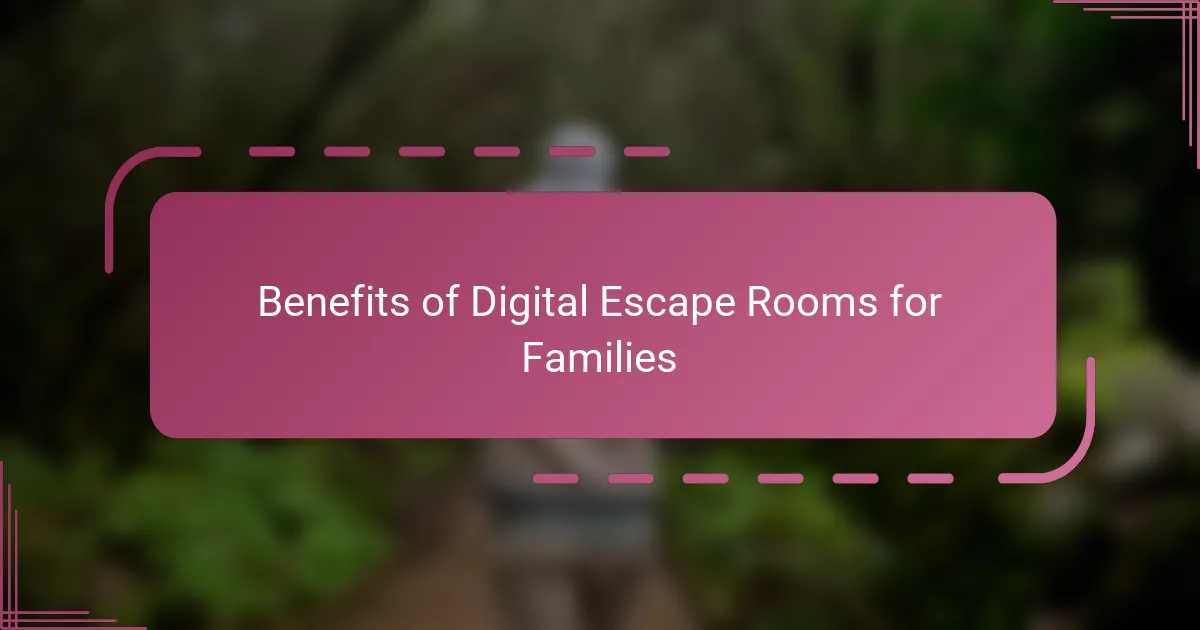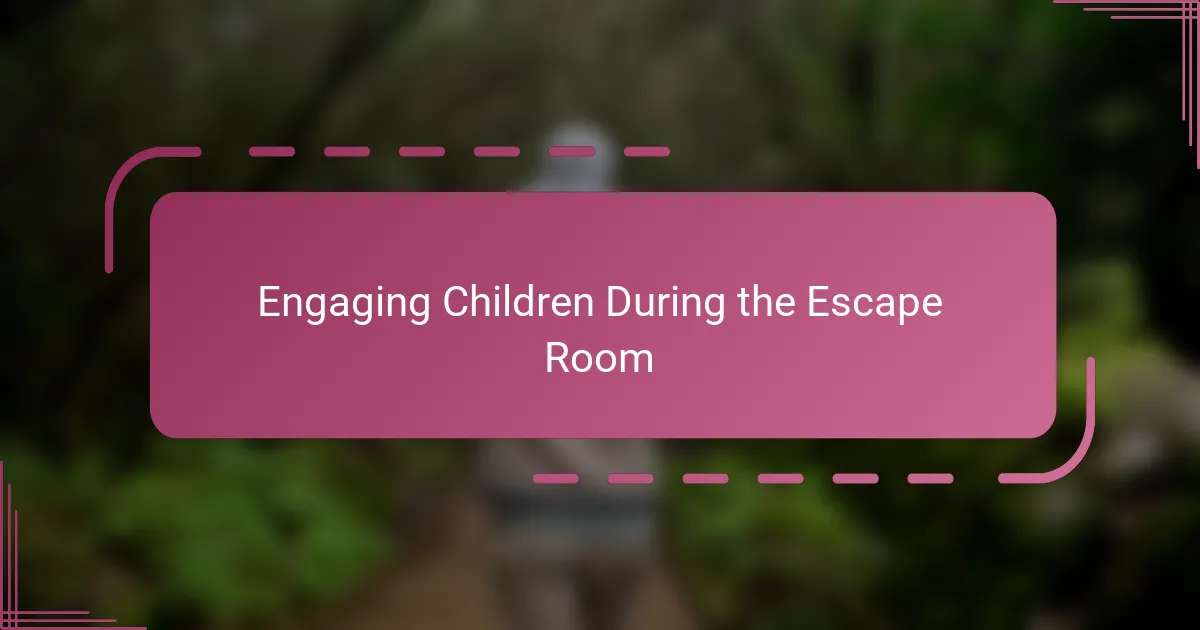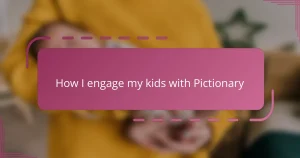Key takeaways
- Digital escape rooms enhance family bonding through communication, teamwork, and creativity.
- Choosing age-appropriate themes and adjusting difficulty keeps engagement high for all family members.
- Effective setup, distraction-free environments, and assigned roles contribute to a smoother gaming experience.
- Patience, flexibility, and positivity during challenges foster problem-solving skills and maintain enthusiasm.

What Are Digital Escape Rooms
Digital escape rooms are interactive online games that challenge players to solve puzzles and riddles within a set time, all from the comfort of home. When I first tried one with my kids, I was amazed at how engaging and immersive the experience was, even without physically being in the same room as an actual escape game.
Have you ever wondered how these virtual puzzles keep your brain ticking and your family communicating? For me, digital escape rooms sparked collaboration and creativity – something I hadn’t expected when we were just looking for a fun way to pass the evening. They truly blend entertainment with problem-solving in a way that feels effortless and deeply rewarding.

Benefits of Digital Escape Rooms for Families
One of the biggest benefits I noticed was how digital escape rooms brought my family closer. We had to listen carefully to each other’s ideas, which naturally improved our communication. Have you ever seen your kids so focused and excited about working together? It was a wonderful change from the usual distractions.
Another thing I appreciated was how inclusive the experience felt. No matter the age or skill level, everyone could contribute in some way. I loved watching my youngest light up when she cracked a code, reminding me that these games build confidence as much as they do teamwork.
Lastly, digital escape rooms offer flexibility that’s hard to beat. You can jump in anytime, anywhere, without needing extra equipment or a big setup. For busy families like mine, that ease makes quality bonding time feel less like a chore and more like a genuine adventure.

How to Choose Suitable Escape Rooms
Choosing the right digital escape room for your family can feel overwhelming, but I found that starting with the age recommendations really helped me narrow down options. After all, there’s no point in picking a game too complex for your kids, or too simple that it bores everyone quickly. Have you noticed how the right difficulty level keeps the whole family engaged and excited rather than frustrated?
I also like to consider the theme and story because that’s what draws my kids in emotionally. Whether it’s a haunted mansion or a space adventure, the narrative can make all the difference in capturing their imagination. When I chose a pirate treasure hunt once, I saw my children’s eyes light up—they were completely hooked from start to finish.
Finally, think about the length and format. When my schedule was tight, I picked shorter escape rooms that still packed a punch, making sure we ended on a high note without feeling rushed. Have you tried balancing fun with practical timing? It’s a game-changer for keeping everyone eager for the next round.

Setting Up for a Successful Game
Getting the setup right is key to keeping the game flowing smoothly. I learned this the hard way the first time—when the kids kept asking me to pause and explain the rules because I hadn’t prepared the devices or shared the instructions clearly beforehand. Have you ever had to juggle technical glitches while trying to stay patient? Trust me, a quick tech check and a clear rundown save so much frustration.
I also found that creating a cozy, distraction-free space makes a big difference. When we turned off phones and settled around the computer with snacks, the kids were more focused and excited. It felt less like a screen time session and more like a special event. Don’t you think setting the mood helps build anticipation and teamwork?
Another tip I swear by is assigning roles before starting—someone to manage the clues, another to keep track of time, and a leader to keep things moving. It gave everyone a sense of responsibility and kept my little ones engaged. Have you noticed how sharing the load creates more enthusiasm and less chaos? It definitely worked wonders for us.

Engaging Children During the Escape Room
Keeping children engaged during a digital escape room often means tapping into what excites them most. In my experience, letting my kids take turns leading the puzzles or narrating our progress made them feel important and kept their attention sharp. Have you tried handing over the reins? It’s surprising how empowered they become when trusted with that responsibility.
I also noticed that mixing in small rewards—like a silly dance or a chance to pick the next snack after solving a tricky clue—worked wonders to sustain enthusiasm. When my kids see immediate fun incentives, the challenge feels less like work and more like play. What little motivators have you found that keep your children eager to tackle the next puzzle?
Of course, patience is key. Sometimes, my kids got stuck or frustrated, and that’s when gentle encouragement and asking questions helped them think differently without feeling pressured. Have you ever seen the light bulb moment when a child figures something out on their own? It’s priceless, and it makes all the engagement efforts totally worth it.

Overcoming Challenges in Gameplay
There were moments when the puzzles felt almost impossible, and I saw my kids’ faces scrunch up with frustration. What helped me was encouraging them to take a deep breath and look at the clues from a different angle. I remember one time when stepping back and asking a simple question unlocked a whole new train of thought—it was such a rewarding “aha” moment for all of us.
Sometimes, the digital format itself introduced unexpected hiccups, like glitches or confusing instructions. Instead of letting these derail the fun, I found that turning challenges into mini team problems—like figuring out how to navigate the interface—kept everyone involved and boosted our problem-solving spirit. Have you ever noticed how overcoming a technical snag together can actually strengthen teamwork?
I also learned that patience and persistence are key ingredients. When one puzzle stumped us for too long, I’d suggest a quick break or switch to a different task to keep energy levels up. This simple shift prevented frustration from taking over and kept the gameplay flowing smoothly. Isn’t it amazing how a little flexibility can turn a challenging moment into an enjoyable part of the adventure?

Lessons Learned from My Experience
One big lesson I took away is that preparation truly makes all the difference. I remember the first time we jumped in without setting clear roles or organizing our space—it quickly turned chaotic, and frustration crept in. Have you ever felt that rush of stress when things spiral? Since then, I’ve made sure to plan ahead, which transformed the experience into seamless fun.
Another insight was how important it is to embrace patience, especially when puzzles get tough or tech hiccups pop up. I’ve seen my kids’ confidence grow when I step back and encourage them to try different approaches instead of rushing to the answer. Isn’t it incredible how a little patience can spark creativity and positivity?
Finally, I realized that flexibility is key. Sometimes, taking a break or switching puzzles helped keep spirits high and energy flowing. I found that by adapting on the fly, the game stayed enjoyable rather than turning into a frustration marathon. How often do we forget that being flexible can actually gift us the best moments in family activities?


